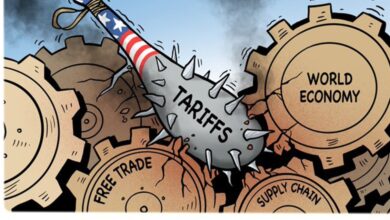Reliance Retail Earnings Expected to Pick Up Pace by 2024, According to Morgan Stanley

Reliance Retail Earnings Expected to Pick Up Pace by 2024, According to Morgan Stanley
By leveraging investments made in both the front-end and back-end of the company, global research and investment management firm Morgan Stanley predicts that Reliance Retail’s earnings would accelerate by the year 2024.
According to the global stockbroker, Reliance Retail’s topline earnings should increase at a compound annual growth rate (CAGR) of 24% during the fiscal years 2024 and 2026. Reliance Retail’s topline expanded at a CAGR of around 19% over the fiscal years 2020 and 2023.

Between FY20 and FY23, earnings before interest, taxes, depreciation, and amortisation (Ebitda) increased at a rate of roughly 30%, with Morgan Stanley predicting that this rate may pick up speed as Reliance Retail expands its operations.
“When there was concrete proof of income, historically Reliance Industries has surpassed projections. According to Morgan Stanley’s analysis on the retail sector from August 24th, “we anticipate a ramp-up in revenue to begin by the end of 2023, with steady growth throughout the course of the next year.
During its annual general meeting (AGM) today, Reliance Industries (RIL) is anticipated to make some big announcements pertaining to its retail division. According to experts following the corporation, this might perhaps contain a road map for expected future investments and ambitions for the company.
When RIL announced last week that Qatar Investment Authority (QIA) would purchase a roughly 1% share in Reliance Retail Ventures (RRVL), the holding company of Reliance Retail (RRL), for $1 billion at a valuation of $100 billion, it provided a hint as to what was to come.

Since then, media sources have speculated that the company may bring on a few more investors, giving them an additional 8–10% in RRVL dilution from RIL. A fully owned subsidiary of RIL is RRVL. A representative for Reliance Retail declined to comment on the situation.
RIL has so far sold 11.08% of its shares in RRVL, including QIA’s stake from last week. A group of private equity investors had previously purchased a 10.09% interest in RRVL for Rs 47,265 crore (or around $6 billion), valuing the company at over Rs 4.2 trillion (or $57 billion).
In its most recent round of fundraising, RIL valued its retail division at $92-96 billion, 10% more than two international consultants (BDO and EY) did last month.
Prior to a planned action to lower the share capital of its unlisted subsidiary RRL by purchasing it back from shareholders other than the promoters and holding company at Rs 1,362 per share, RIL hired the two independent valuers.
In direct contrast to competitor Avenue Supermarts, which operates the DMart network of shops, and Shoppers Stop, the nation’s oldest department store chain, which posted lacklustre figures for the quarter, Reliance Retail’s performance for the June quarter stood out.
According to Morgan Stanley, RIL is entering a phase in which the monetization and investment cycles will coexist until 2027. According to Morgan Stanley, “This multi-decade profile shifts offers under-appreciated opportunities, especially as the earnings cycle turns.”
The brokerage said that investments in growth sectors were accelerating and that RIL’s capex to cashflow cycles were decreasing from 5 to 6 years to 2-3 years.

In a recently published report, global financial services firm Morgan Stanley has predicted that Reliance Retail, the retail arm of Reliance Industries, will witness substantial growth in earnings by the year 2024. This analysis comes as the retail giant continues to make strides in expanding its footprint across India, while also making inroads in the digital marketplace through its online platforms.
Reliance Retail is a subsidiary of Reliance Industries Limited, one of India’s most diversified conglomerates, with interests in sectors like petrochemicals, refining, and telecommunications. As the largest retail chain in India, Reliance Retail operates over 12,000 stores across the country, featuring a diverse product portfolio that includes groceries, electronics, apparel, and footwear.
The company has been aggressively expanding into smaller cities and towns, thereby tapping into India’s burgeoning middle class. The decision to expand the retail network is strategic, aiming to be within 2 km of 95% of all Indian households in the next few years.
Another contributing factor is the company’s increasing focus on digitization and online sales. Through platforms like JioMart, which has seen substantial growth during the pandemic, Reliance Retail is well-placed to gain from the increasing penetration of the internet and online shopping.

Reliance Retail’s wide product offering also makes it resilient to economic fluctuations. During the pandemic, while other retail sectors witnessed a decline, Reliance Retail’s grocery and electronics segments performed exceptionally well.
The company’s strategy of acquiring or partnering with local retailers has provided an instant network and customer base. It recently acquired Future Retail and has also entered into strategic partnerships with international brands like Burberry, Steve Madden, and Marks & Spencer, among others.
Morgan Stanley’s report predicts that Earnings Before Interest, Taxes, Depreciation, and Amortization (EBITDA) could potentially double by 2024, driven by increasing revenue and tighter cost control. The report also anticipates an annual growth rate of approximately 15-18% in revenue over the next three years.
However, the report also warns of potential risks such as regulatory hurdles, competitive pressure from e-commerce giants like Amazon and Flipkart, and the volatile global economic situation.
Reliance Retail appears to be on a robust growth trajectory, backed by strategic expansions, a broad product portfolio, and digital initiatives. The financial forecasts by Morgan Stanley seem to echo the optimism of other industry analysts, making Reliance Retail a noteworthy player in both the Indian retail market and the global arena.
Investors and market watchers will certainly be keen to see if the company’s performance aligns with these bullish projections in the coming months.





